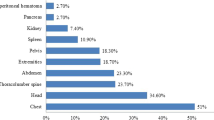Abstract
Objective
To present our experience of multidisciplinary management of high-grade pediatric liver injuries.
Introduction
Pediatric high-grade liver injuries pose significant challenge to management due to associated morbidity and mortality. Emergency surgical intervention to control hemorrhage and biliary leak in these patients is usually suboptimal. Conservative management in selected high-grade liver injuries is now becoming standard of care. Management of hemobilia due to pseudoaneurysm formation and traumatic bile leaks requires multidisciplinary management.
Methods
A retrospective review was undertaken for patients presenting with blunt liver injuries at two tertiary care centers in Karachi, Pakistan, from March 2021 to December 2022. Twenty-eight patients were identified, and four patients fulfilled the criteria for grade 4 and above blunt liver injury during this period.
Results
One case with grade 4 liver injury developed hemobilia on 7th day of injury. He required two settings of angioembolization but had recurrent leak from pseudoaneurysm. He ultimately needed right hepatic artery ligation. Second patient presented with massive biliary peritonitis 2 days following injury. He was managed initially with tube laparostomy followed by ERCP and stent placement. The third patient developed large hemoperitoneum managed conservatively. One case with grade 5 injury expired during emergency surgery.
Conclusion
Conservative management of advanced liver injuries can result in significant morbidity and mortality due to high risk of complications. Trauma surgeons need to have multidisciplinary team for management of these patients to gain optimal outcome.




Similar content being viewed by others
Data Availability
Data will be available on request.
References
Disease burden and mortality estimates [Internet]. World Health organization 2021 [Accessed on 21st April, 2021]. Available from https://www.who.int/healthinfo/global_burden_disease/estimates/en/.
Karamercan A, Yilmaz TU, Karamercan MA, Aytaç B. Blunt abdominal trauma: evaluation of diagnostic options and surgical outcomes. Ulus Travma Acil Cerrahi Derg. 2008;14:205–10.
Lida A, Ryuko T, Kemmotsu M, Ishii H, Naito H, Nakao A. Three-year-old traumatic liver injury patient treated successfully using transcatheter arterial embolization. Int J Surg Case Rep. 2020;70:205–8. https://doi.org/10.1016/j.ijscr.2020.04.036.
Van As AB, Millar AJ. Management of paediatric liver trauma. Pediatr Surg Int. 2017;33(4):445–53. https://doi.org/10.1007/s00383-016-4046-3.
Piper GL, Peitzman AB. Current management of hepatic trauma. Surg Clin North Am. 2010;90(4):775–85. https://doi.org/10.1016/j.suc.2010.04.009.
Coccolini F, Coimbra R, Ordonez C, et al. Liver trauma: WSES 2020 guidelines. World J Emerg Surg. 2020;15(1):24. https://doi.org/10.1186/s13017-020-00302-7.
Bala M, Gazalla SA, Faroja M, Bloom AI, Zamir G, Rivkind AI, et al. Complications of high-grade liver injuries: management and outcome with focus on bile leaks. Scand J Trauma Resusc Emerg Med. 2012;20:20. https://doi.org/10.1186/1757-7241-20-20.
Kozar RA, Crandall M, Shanmuganathan K, Zarzaur BL, Coburn M, Cribari C, Kaups K, Schuster K, Tominaga GT, AAST Patient Assessment Committee. Organ injury scaling 2018 update: spleen, liver, and kidney. J Trauma Acute Care Surg. 2018;85(6):1119–22.
Asensio JA, Roldán G, Petrone P, Rojo E, Tillou A, Kuncir E, et al. Operative management and outcomes in 103 AAST-OIS grades IV and V complex hepatic injuries: trauma surgeons still need to operate, but angioembolization helps. J Trauma Acute Care Surg. 2003;54(4):647–54.
Asensio JA, Demetriades D, Chahwan S, Gomez H, Hanpeter D, Velmahos G, et al. Approach to the management of complex hepatic injuries. J Trauma Acute Care Surg. 2000;48(1):66.
Yoon W, Jeong YY, Kim JK, Seo JJ, Lim HS, Shin SS, et al. CT in blunt liver trauma. Radiographics. 2005;25(1):87–104.
Brooks A, Reilly JJ, Hope C, Navarro A, Naess PA, Gaarder C. Evolution of non-operative management of liver trauma. Trauma Surg Acute Care Open. 2020;5(1): e000551.
Tiwari C, Shah H, Waghmare M, Khedkar K, Dwivedi P. Management of traumatic liver and bile duct laceration. Euroasian J Hepatogastroenterol. 2017;7(2):188–90. https://doi.org/10.5005/jp-journals-10018-1247.
Østerballe L, Helgstrand F, Axelsen T, Hillingsø J, Svendsen LB. Hepatic pseudoaneurysm after traumatic liver injury; is CT follow-up warranted? J Trauma Manag Outcomes. 2014;8:18. https://doi.org/10.1186/1752-2897-8-18.
Notrica DM, Eubanks JW 3rd, Tuggle DW, Maxson RT, Letton RW, Garcia NM, Alder AC, Lawson KA, St Peter SD, Megison S, Garcia-Filion P. Nonoperative management of blunt liver and spleen injury in children: evaluation of the ATOMAC guideline using GRADE. J Trauma Acute Care Surg. 2015;79(4):683–93. https://doi.org/10.1097/TA.0000000000000808.
Murugesan SD, Sathyanesan J, Lakshmanan A, Ramaswami S, Perumal S, Perumal SU, et al. Massive hemobilia: a diagnostic and therapeutic challenge. World J Surg. 2014;38(7):1755–62.
Kulaylat AN, Stokes AL, Engbrecht BW, McIntyre JS, Rzucidlo SE, Cilley RE. Traumatic bile leaks from blunt liver injury in children: a multidisciplinary and minimally invasive approach to management. J Pediatr Surg. 2014;49(3):424–7. https://doi.org/10.1016/j.jpedsurg.2013.07.015.
Swendiman RA, Goldshore MA, Fenton SJ, Nance ML. Defining the role of angioembolization in pediatric isolated blunt solid organ injury. J Pediatr Surg. 2020;55(4):688–92. https://doi.org/10.1016/j.jpedsurg.2019.04.036.
Author information
Authors and Affiliations
Corresponding author
Ethics declarations
Ethical approval was waived by the local Ethics Committee of Dow University of Health Sciences in view of the retrospective nature of the study and all the procedures being performed were part of the routine care.
Conflict of interest
The authors declare no competing interests.
Rights and permissions
Springer Nature or its licensor (e.g. a society or other partner) holds exclusive rights to this article under a publishing agreement with the author(s) or other rightsholder(s); author self-archiving of the accepted manuscript version of this article is solely governed by the terms of such publishing agreement and applicable law.
About this article
Cite this article
Ali, S.W., Salim, A., Aslam, U. et al. Multidisciplinary management of high-grade pediatric liver injuries. Eur J Trauma Emerg Surg (2024). https://doi.org/10.1007/s00068-023-02439-x
Received:
Accepted:
Published:
DOI: https://doi.org/10.1007/s00068-023-02439-x




